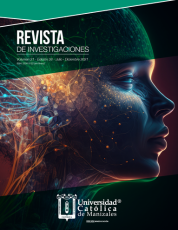Teaching strategies for engagement and their influence on teachers' repertoire
DOI:
https://doi.org/10.22383/ri.v21i38.185Keywords:
English courses, engagement, teacher strategies, teacher's repertoire, studentsAbstract
This case study is about a male pre-service EFL teacher facing adult learners in a Private University in Medellin, Colombia that shaped his experience through the implementation of some engagement teaching strategies to build a positive learning environment and contribute to his repertoire as a professional in the education field. Data collected through the teacher’s interview, researchers’ observation format, and students’ questionnaires were analyzed using codes and matrixes. The findings identified three engagement teaching strategies that the preservice teacher applied consciously inside the classroom, evidencing these as part of his repertoire. The findings also revealed when the preservice teacher uses his strategies in class: building rapport, teacher’s check, and collaborative work, they are recognized by his students. The study could strengthen the significant role
of the teacher and the importance of the teacher’s self-awareness to think about how to constantly build his repertoire and improve his practice.
References
Buskist, W., Busler, J., Kirby L. (2018). Rules of (student) engagement. New Directions for Teaching and Learning, Vol. 2018 (154), 55-63., DOI: https://doi.org/10.1002/tl.20291
Darling-Hammond, L. (1999). Teacher Quality and Student Achievement. Education policy analysis archives, 8, 1-1 DOI: https://doi.org/10.14507/epaa.v8n1.2000
Harper, S. R., & Quaye, S. J. (2009). Beyond sameness, with engagement and outcomes for all. Student engagement in higher education, 1-15. DOI: https://doi.org/10.4324/9780203894125
Ibrahim, N., Shak, M. S. Y., Mohd, T., Ismail, N. A., Perumal, P. D. A., Zaidi, A., & Yasin, S. M. A. (2015). The Importance of Implementing Collaborative Learning in the English as a Second Language (ESL) Classroom in Malaysia. Procedia Economics and Finance, 31, 346–353. DOI: https://doi.org/10.1016/S2212-5671(15)01208-3
Kazemi, A., & Soleimani, N. (2016). On the relationship between EFL teachers’ classroom management approaches and the dominant teaching style: A mixed method study. Iranian Journal of Language Teaching Research, 4(2), 87-103.
Killen, R. (2002). Effective Teaching Strategies Lessons from research and practice. Cengage Learning Australia
Klette, K. (1997). Teacher Individuality, Teacher Collaboration and Repertoire‐Building: some principal dilemmas. Teachers and Teaching, 3(2), 243-256. DOI: https://doi.org/10.1080/1354060970030206
Knowles, M. (1975). Self-Directed Learning. Chicago: Follet.
Knowles, M. (1984). Andragogy in Action. San Francisco: Jossey-Bass.
Knowles, M. (1984). The Adult Learner: A Neglected Species (3rd Ed.). Houston: Gulf Publishing.
Krause, K. L., & Coates, H. (2008). Students’ engagement in first‐year university. Assessment & Evaluation in Higher Education, 33(5), 493-505. DOI: https://doi.org/10.1080/02602930701698892
Kuh, G. D., Kinzie, J., Buckley, J. A., Bridges, B. K., & Hayek, J. C. (2011). Piecing together the student success puzzle: Research, propositions, and recommendations: ASHE higher education report (Vol. 116). John Wiley & Sons.
Kumaravadivelu, B. (1994). The postmethod condition: Emerging strategies for second/ foreign language teaching. TESOL Quarterly, 28(1), 27-48. DOI: https://doi.org/10.2307/3587197
Ministerio de Educación Nacional, (1994) Decreto 1860. por el cual se reglamenta parcialmente la Ley 115 de 1994. Bogotá, Colombia, 3 de agosto de 1994.
Ministerio de Educación Nacional, (2009) Documento No. 11. Fundamentaciones y orientaciones para la implementación del Decreto 1290. Bogotá, Colombia, 16 de abril de 2009.
Ministerio de Educación Nacional, (2015). Decreto 1075 por medio del cual se expide el Decreto Único Reglamentario del Sector Educativo. Bogotá, Colombia, 26 de mayo de 2015.
Pamplona-Raigosa, J., Cuesta-Saldarriaga, J. C., & Cano-Valderrama, V. (2019). Teacher teaching strategies in basic areas: a look at school learning. Revista eleuthera, 21, 13-33. DOI: https://doi.org/10.17151/eleu.2019.21.2
Reddington E, (2018). Managing participation in the adult ESL classroom: engagement and exit practices. Classroom Discourse 9(2):1-18 DOI: https://doi.org/10.1080/19463014.2018.1433051
Sarode, Ravindra (2018). Teaching strategies, styles and qualities of a teacher: a review for valuable higher education. International journal of current engineering and scientific research (IJCESR), 5, 57-62
Savin-Baden, M., & Howell-Major, C. (2013). Qualitative research: The essential guide to theory and practice. Qualitative Research: The Essential Guide to Theory and Practice. Routledge
Seyoung H. (2010). Narrative inquiry for science education: teachers’ repertoire-making in the case of environmental curriculum. International Journal of Science Education, Taylor & Francis (Routledge). pp 13-14
Downloads
Published
How to Cite
Issue
Section
License
Copyright (c) 2021 Revista de Investigaciones

This work is licensed under a Creative Commons Attribution-NonCommercial 4.0 International License.
Attribution — You must give appropriate credit, provide a link to the license, and indicate if changes were made. You may do so in any reasonable manner, but not in any way that suggests the licensor endorses you or your use.
NonCommercial — You may not use the material for commercial purposes.
This work is licensed under a Creative Commons Attribution-NonCommercial 4.0 International License.












